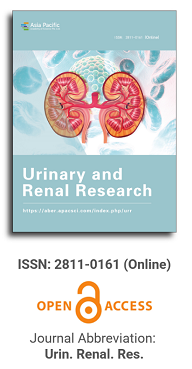
Asia Pacific Academy of Science Pte. Ltd. (APACSCI) specializes in international journal publishing. APACSCI adopts the open access publishing model and provides an important communication bridge for academic groups whose interest fields include engineering, technology, medicine, computer, mathematics, agriculture and forestry, and environment.
Sterological analysis of podocyte mitochondria in adriamycin nephropathy rats
Vol 1, Issue 1, 2020
Download PDF
Abstract
Objective: To disclose the relationship between mitochondrial morphology, density and pro-teinuria in adriamycin nephropathy rats. Method: Thirty Sprague Dawley rats of clean grade were divided into adriamycin group and control group. In adriamycin nephropathy group, rats were given adriamycin at dosage of 0.7 mg /100 g body weight by tail vein injection. The control rats received equal volume of sa-line. At 2 weeks (control group = 3, adriamycin group = 3) , 4 weeks (control = 3, adriamycin group =6) and 6 weeks (control = 8, adriamycin group = 7) after adriamycin injection, the rats were sacrificed and kidneys were harvested for preparation of ultra-thin sections. Electron microscopy was performed, and podocyte mitochondrial morphology was observed. Sterological analysis was performed on morphology and density of mitochondria in podocytes. Results: 4 weeks after adriamycin injection, the rats developed proteinuria until 6 weeks. Mitochondria in the podocytes from control rats showed ellipsoid shape. Differ-ent shaped and sized mitochondria were observed in podocytes of the adriamycin nephropathy rats. No sig-nificant statistical difference was revealed in the mitochondrial area, circumference, form factor and aspect ratio between adriamycin and control groups. Before development of proteinuria, the mitochondrial density increased significantly at 2 weeks after adriamycin injection compared with that in control rats (0.17±0.00 vs. 0.14±0.01, t = 6.173, P < 0.01). Meanwhile, the surface density of mitochondria showed an increasing trend (0.78±0.03 vs. 0.71±0.04, t =-2.526, P = 0.065). 6 weeks after adriamycin injection, the surface density of mitochondria decreased significantly compared with that in the control rats (0.71±0.11 vs. 0.87±0.12, P = 0.02) , the density of mitochondria did not change significantly. Conclusions Dysmorphic mitochondria are involved in the development of proteinuria in adriamycin ne-phropathy. The increase of mitochondrial density is an early event in the development of proteinuria. De-crease of mitochondria surface density is involved in podocyte injury and development of adriamycin ne-phropathy rats.
Keywords
References
- Guan Na, Ding Jie, Yang Jiyun, et al. Chinical charac-teristics and prognosis analysis of children with idiopathic nephrotic syndrome with different responses to steroid therapy from a single center in 20 years[J]. Chinese Journal of Applied Clinical Pediatric, 2014, 29 (17) : 1291-1295. (in Chinese)
- Deng Jianghong, Ding Jie, Guan Na, et al. Morphomet-ric analysis of of glomerular foot process in puromycin aminonucleoside nephropathy in rat[J]. Chinese Journal of Sterology and Image Analysis, 2003, 8 (1) : 9-15. (in Chinese)
- Tharaux P L, Huber T B. How many ways can a podo-cyte die? [J]. Seminars in Nephrology, 2012 , 32(4) : 394-404.
- Hotta O, Inoue C N, Miyabayashi S, et al. Clinical and pathologic features of focal segmental glomerulosclerosis with mitochondrial trna Leu (UUR) gene mutation [J]. Kidney International, 2001, 59(4) : 1236-1243.
- Guan Na. Progress in diagnosis and treatment of mito-chondrial nephropathy[J]. Chinese Journal of Pediatric, 2014, 52(7) : 503-505. (in Chinese)
- Xie Kewei, Gu Leyi. Mitochondria injury and glomerular dis-ease[J]. Chiese Journal of Integrated Traditional and West-ern Nephrology, 2013, 14(3) : 360-362. (in Chinese)
- He Weichun, Yang Junwei. The study progression of mi-tochondria and podocyte[J]. Chinese Journal of Neph-rology, 2007, 23(1) : 61-63. (in Chinese)
- Zhu C, Xuan X, Che R, et al. Dysfunction of the PGC-1 α-mitochondria axis confers adriamycin-in-duced podocyte injury[J]. American Journal of Physiology-Renal Physiology, 2014, 306(12) : 1410-1417.
- GüCer S, Talim B, Asan E, et al. Focal segmental glomer-ulosclerosis associated with mitochondrial cytopathy: report of two cases with special emphasis on podocytes [J]. Pedi-atric Developmnetal Pathology, 2005, 8(6) : 710-717.
- Yang Zhengwei. The basic tools for the study of quantita-tive morphology of biological tissue: The utility of stereo-logical method[M]. Beijing: Science Press, 2012. (in Chinese)
- Imasawa T, Rossignol R. Podocyte energy metabolism and glomerular diseases[J]. The International Journal of Biochemistry and Cell, 2013, 45(9) : 2109-2118.
- Dinour D,mini S, Polak-Charcon S, et al. Progressive nephropathy associated with mitochondrial trna gene mu-tation[J]. Clinical Nephrology, 2004, 62(2) : 149-154.
- Barisoni L, Madaio M P, Eraso M, et al. The kd/kd mouse is a model of collapsing glomerulopathy [J]. Jour-nal of the American Society of Nephrology, 2005, 16 (10) : 2847-2851.
- Markowitz G S, Appel G B, Fine P L, et al. Collapsing focal segmental glomerulosclerosis following treatment with high-dose pamidronate[J]. Journal of the American Society Nephrology, 2001, 12(6) : 1164-1172.
- Coimbra T M, Janssen U, Grne H J, et al. Early events leading to renal injury in obese Zucker (fatty) rats with type II diabetes[J]. Kidney International, 2000, 57(1) : 167-182.
- Mannella C A, Lederer W J, Jafri M S. The connection between inner membrane topology and mitochondrial function[J]. Journal of Molecular and Cellular Cardi-olgy, 2013, 62: 51-57
Supporting Agencies
Copyright (c) 2020 Xiaoya Liu, Yali Ren, Na Guan, Sainan Zhu, Guosheng Yang, Yinghong Tao

This work is licensed under a Creative Commons Attribution-NonCommercial 4.0 International License.

This site is licensed under a Creative Commons Attribution 4.0 International License (CC BY 4.0).
.png)
Prof. Wei-Yen Hsu
National Chung Cheng University, Taiwan

